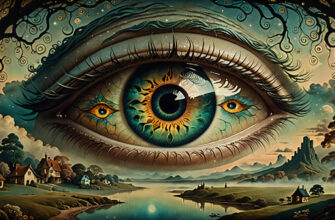Anyone who’s ever jolted awake, heart racing, body slick with sweat — knows that nightmares hit differently. They can cling to you all day, like a thick fog you can’t shake off. But what if they weren’t just random jolts of fear? What if bad dreams were telling you something you’ve ignored for too long?
More than just spooky stories unfolding behind your eyelids, nightmares serve as emotional smoke signals from your subconscious. Your brain can’t always say, “Hey, you’re overwhelmed.” So, instead, it sends you plummeting off a cliff or makes your teeth shatter like porcelain. These symbols aren’t punishment. They’re attention-grabbers.
Nightmares often reflect what you’re too pressed to deal with while awake: the job stress you bury, the grief you won’t name, the fear you refuse to speak out loud. Anxiety, trauma, even buried guilt—nightmares pull them all into technicolor and serve them up raw.
Some of the most common triggers for these nighttime panic reels include:
- Anxiety, stress, and feeling constantly overstimulated
- Past trauma that’s still unresolved and finding new ways to surface
- Suppressed emotions—especially ones that feel unsafe to express
Then there are the usual suspects. Ever dreamt of losing your teeth? Falling into the sky? Being chased by a faceless thing? You’re not alone. These themes pile up when you’ve been pushing your limits, people-pleasing too much, or losing your grip on what you can control.
What Are Nightmares Really Saying?
They might not use words, but nightmares speak. Loudly. A recurring fall could point to your deep fear of failure. An out-of-control car might echo how your life feels at work, in love, or at home.
Let’s break a few of these iconic symbols down:
| Nightmare Symbol | What It Might Mean |
|---|---|
| Being chased | Avoiding a truth, fear, or decision |
| Falling | Loss of control, insecurity, or failure fears |
| Teeth falling out | Loss of power, self-expression, or control |
| Being naked in public | Shame, vulnerability, or fear of judgment |
| Drowning | Feeling emotionally overwhelmed |
Many dreams zero in on themes around boundaries, violations, or helplessness—triggers that often have roots in old wounds. These dreams don’t “come out of nowhere.” They are pressure valves when the emotional buildup gets too heavy.
Timing And Triggers Behind Nightmares
Nightmares love chaos and turning points. They often surge during life changes—moves, breakups, job shifts—or even around those pesky anniversary dates your body remembers before your calendar does. If you’ve ever had a sudden spike in bad dreams and couldn’t place why, ask:
- Am I going through a life transition—even a “good” one?
- Is my nervous system low-key freaking out every night I go to sleep?
- Did something happen around this time in the past that I’m not consciously thinking about?
Lack of sleep, changing hormones, or even side effects from medication can also stir up nightmare fuel. Your physical body carries stress just as much as your mind does, and that tension doesn’t disappear when your head hits the pillow.
Nightmares tend to spike in adulthood not because things get worse—but because things pile up. We stop giving ourselves space to fully feel or process. So what does your psyche do? It kicks down the door.
Your subconscious won’t whisper forever. If you’re not listening during the day, it gets louder at night. Those dreams that have you waking up unsettled and exhausted? They’re built from the silence you’re keeping when you’re supposed to be calm.
Through Jung’s Eyes: What Nightmares Reveal
Carl Jung didn’t believe dreams were meaningless static. To him, nightmares were spiritual post-its from your inner self—the parts of you that don’t get to talk loudly during the day.
Instead of focusing on random visuals, Jung asked: What emotion did the dream leave behind?
He saw nightmares as messages from what he called “the shadow self”—aspects of your personality you’ve rejected, shamed, or ignored. That terrifying monster in your dream? Might symbolize a part of yourself you find unacceptable. The one you buried in order to “fit in” or stay safe.
Some nightmare symbols Jung would flag as deeply archetypal include:
- The monster – A representation of our hidden fears or a part of ourselves we judge harshly
- The fall – A pull toward surrender, growth, or identity upheaval
- The mirror – A confrontation with how we really see ourselves, unfiltered
And when it comes to those scenes that keep playing out on repeat?
– Being chased might be your mind’s way of saying: You’re avoiding something real—truth, confrontation, or even grief.
– Losing teeth usually points to control issues, fear of powerlessness, or fear of aging & change—anything that makes you feel exposed.
Underneath all of it is usually a heartbeat tying your unconscious feelings to your conscious life. Your nightmares aren’t random. And they’re rarely lying.
Nightmares as a Mirror: Facing What You’re Avoiding
Why do the same terrifying scenes show up again and again in your sleep? What does it mean when your nightmares don’t just repeat, but get more intense, more twisted?
It usually means there’s something your brain’s been begging you to deal with in your waking life—heartbreak that never fully healed, grief you’ve ducked behind busyness, or a pattern you keep running from. Nightmares love throwing it in your face, metaphor-style.
Dreams don’t speak plain English. You won’t dream of your ex—you’ll dream your house is flooding or your teeth are falling out. Those visuals are loaded with emotion. The trick is recognizing that the symbols hold clues. Literal isn’t the language. Metaphor is.
When your days are filled with numbing out—overworking, scrolling, stuffing emotions down—your nights pick up the slack. That emotional backlog finds a release valve during REM sleep.
And here’s the cost: if you never feel safe enough in life to let yourself fully feel, your dreams do the screaming for you. That’s why avoidance never really works. It just shows up after dark.
Chronic anxiety pulls the same trick. If you’re always riding stress like a wave, your dreams often replay worst-case scenarios. Over and over. Until you listen.
Using Nightmares to Heal
Waking up shaken from a nightmare? Instead of pushing it away, ask something deeper: “What part of me was trying to speak?”
Grab a journal—fast. Don’t let your logical brain kick in just yet. Capture every weird detail from the dream before it slips. Weird cat eyes, broken elevators, those shadowy figures—they all have something to say.
- Shadow work: Those terrifying figures? Often pieces of yourself you find ugly, shameful, or dangerous. Getting curious about them instead of hiding can trigger emotional breakthroughs.
- Inner child work: Recurring dreams about being abandoned or helpless? That’s probably a younger version of you showing up and asking to be heard, protected, held.
Sometimes the feelings stirred up are too huge to hold alone. Bringing your dreams into therapy—especially with someone trauma-aware or Jungian-trained—can turn those midnight monsters into maps.
A single dream may feel chaotic or confusing, but when you write them down consistently, patterns start to form. It’s not about decoding every symbol. It’s about recognizing which emotions keep circling back around—and where they lead.
Nightmares vs. Sleep Paralysis or Night Terrors
Not all scary sleep episodes are created equal. Knowing what you’re dealing with helps.
- Nightmares: Emotional dreams you typically remember. They wake you up in fear or sadness, but you can usually recall most of the story.
- Sleep paralysis: You’re conscious but frozen. Often accompanied by disturbing hallucinations and a deep sense of dread.
- Night terrors: Happen more in kids. It’s like the body freaks out but there’s no memory of the trigger—just panic and physical reaction.
If the fear lingers into the day, messes with your sleep, or makes you avoid bedtime altogether, that’s serious. Disturbed sleep affects mood, memory, and even your sense of safety. That’s when reaching out for help isn’t just valid—it’s necessary.








